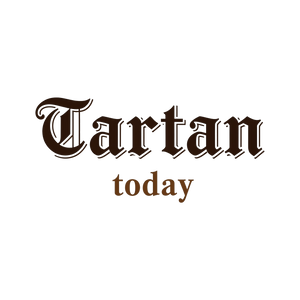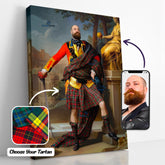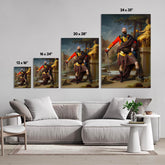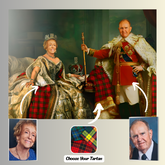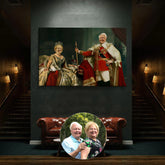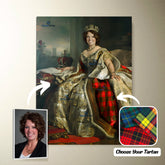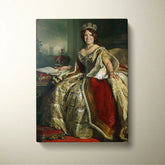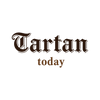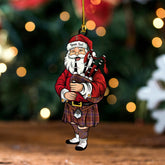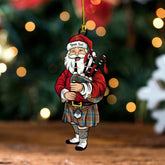-
Personalized Clan Balfour Blue Tartan Bagpipe Ornament with Custom Name – Scottish Christmas Tree Decoration PU36
Personalized Clan Balfour Blue Tartan Bagpipe Ornament with Custom Name – Scottish Christmas Tree Decoration PU36Celebrate your Scottish heritage with this unique wood & acrylic tartan ornament. Perfect as a personalized Christmas decoration or a meaningful gift for friends and relatives on special occasions...- From $19.99 USD
$25.99 USD- From $19.99 USD
- Unit price
- per
Save $6.00 -
Personalized Clan Balfour Modern Tartan Drummer Ornament with Custom Name – Scottish Christmas Tree Decoration TC44
Personalized Clan Balfour Modern Tartan Drummer Ornament with Custom Name – Scottish Christmas Tree Decoration TC44Celebrate your Scottish heritage with this unique wood & acrylic tartan ornament. Perfect as a personalized Christmas decoration or a meaningful gift for friends and relatives on special occasions...- From $19.99 USD
$25.99 USD- From $19.99 USD
- Unit price
- per
Save $6.00 -
Personalized Clan Balfour Blue Tartan Drummer Ornament with Custom Name – Scottish Christmas Tree Decoration IX30
Personalized Clan Balfour Blue Tartan Drummer Ornament with Custom Name – Scottish Christmas Tree Decoration IX30Celebrate your Scottish heritage with this unique wood & acrylic tartan ornament. Perfect as a personalized Christmas decoration or a meaningful gift for friends and relatives on special occasions...- From $19.99 USD
$25.99 USD- From $19.99 USD
- Unit price
- per
Save $6.00 -
Personalized Clan Balfour Reproduction Tartan Bagpipe Ornament with Custom Name – Scottish Christmas Tree Decoration QB84
Personalized Clan Balfour Reproduction Tartan Bagpipe Ornament with Custom Name – Scottish Christmas Tree Decoration QB84Celebrate your Scottish heritage with this unique wood & acrylic tartan ornament. Perfect as a personalized Christmas decoration or a meaningful gift for friends and relatives on special occasions...- From $19.99 USD
$25.99 USD- From $19.99 USD
- Unit price
- per
Save $6.00 -
Personalized Clan Balfour Hunting Reproduction Tartan Bagpipe Ornament with Custom Name – Scottish Christmas Tree Decoration QS83
Personalized Clan Balfour Hunting Reproduction Tartan Bagpipe Ornament with Custom Name – Scottish Christmas Tree Decoration QS83Celebrate your Scottish heritage with this unique wood & acrylic tartan ornament. Perfect as a personalized Christmas decoration or a meaningful gift for friends and relatives on special...- From $19.99 USD
$25.99 USD- From $19.99 USD
- Unit price
- per
Save $6.00 -
Personalized Clan Balfour Hunting Modern Tartan Bagpipe Ornament with Custom Name – Scottish Christmas Tree Decoration FN44
Personalized Clan Balfour Hunting Modern Tartan Bagpipe Ornament with Custom Name – Scottish Christmas Tree Decoration FN44Celebrate your Scottish heritage with this unique wood & acrylic tartan ornament. Perfect as a personalized Christmas decoration or a meaningful gift for friends and relatives on special...- From $19.99 USD
$25.99 USD- From $19.99 USD
- Unit price
- per
Save $6.00 -
Personalized Clan Balfour Hunting Ancient Tartan Bagpipe Ornament with Custom Name – Scottish Christmas Tree Decoration FB51
Personalized Clan Balfour Hunting Ancient Tartan Bagpipe Ornament with Custom Name – Scottish Christmas Tree Decoration FB51Celebrate your Scottish heritage with this unique wood & acrylic tartan ornament. Perfect as a personalized Christmas decoration or a meaningful gift for friends and relatives on special...- From $19.99 USD
$25.99 USD- From $19.99 USD
- Unit price
- per
Save $6.00 -
Personalized Clan Balfour Blue Tartan Bagpipe Ornament with Custom Name – Scottish Christmas Tree Decoration UV26
Personalized Clan Balfour Blue Tartan Bagpipe Ornament with Custom Name – Scottish Christmas Tree Decoration UV26Celebrate your Scottish heritage with this unique wood & acrylic tartan ornament. Perfect as a personalized Christmas decoration or a meaningful gift for friends and relatives on special occasions...- From $19.99 USD
$25.99 USD- From $19.99 USD
- Unit price
- per
Save $6.00 -
Personalized Clan Balfour Blue Reproduction Tartan Bagpipe Ornament with Custom Name – Scottish Christmas Tree Decoration IJ22
Personalized Clan Balfour Blue Reproduction Tartan Bagpipe Ornament with Custom Name – Scottish Christmas Tree Decoration IJ22Celebrate your Scottish heritage with this unique wood & acrylic tartan ornament. Perfect as a personalized Christmas decoration or a meaningful gift for friends and relatives on special...- From $19.99 USD
$25.99 USD- From $19.99 USD
- Unit price
- per
Save $6.00 -
Personalized Clan Balfour Blue Modern Tartan Bagpipe Ornament with Custom Name – Scottish Christmas Tree Decoration YB82
Personalized Clan Balfour Blue Modern Tartan Bagpipe Ornament with Custom Name – Scottish Christmas Tree Decoration YB82Celebrate your Scottish heritage with this unique wood & acrylic tartan ornament. Perfect as a personalized Christmas decoration or a meaningful gift for friends and relatives on special...- From $19.99 USD
$25.99 USD- From $19.99 USD
- Unit price
- per
Save $6.00 -
Personalized Clan Balfour Blue Ancient Tartan Bagpipe Ornament with Custom Name – Scottish Christmas Tree Decoration YS62
Personalized Clan Balfour Blue Ancient Tartan Bagpipe Ornament with Custom Name – Scottish Christmas Tree Decoration YS62Celebrate your Scottish heritage with this unique wood & acrylic tartan ornament. Perfect as a personalized Christmas decoration or a meaningful gift for friends and relatives on special...- From $19.99 USD
$25.99 USD- From $19.99 USD
- Unit price
- per
Save $6.00 -
Personalized Clan Balfour Ancient Tartan Bagpipe Ornament with Custom Name – Scottish Christmas Tree Decoration FN37
Personalized Clan Balfour Ancient Tartan Bagpipe Ornament with Custom Name – Scottish Christmas Tree Decoration FN37Celebrate your Scottish heritage with this unique wood & acrylic tartan ornament. Perfect as a personalized Christmas decoration or a meaningful gift for friends and relatives on special occasions...- From $19.99 USD
$25.99 USD- From $19.99 USD
- Unit price
- per
Save $6.00 -
Personalized Clan Balfour Modern Tartan Bagpipe Ornament with Custom Name – Scottish Christmas Tree Decoration PM17
Personalized Clan Balfour Modern Tartan Bagpipe Ornament with Custom Name – Scottish Christmas Tree Decoration PM17Celebrate your Scottish heritage with this unique wood & acrylic tartan ornament. Perfect as a personalized Christmas decoration or a meaningful gift for friends and relatives on special occasions...- From $19.99 USD
$25.99 USD- From $19.99 USD
- Unit price
- per
Save $6.00 -
Personalized Clan Balfour Modern Clan Crest Tartan Santa Ornament – Custom Acrylic Christmas Decoration ZZ20 - Balfour
Personalized Clan Balfour Modern Clan Badge Tartan Ornament – Custom Acrylic Christmas Decoration ZZ20Celebrate your Scottish heritage with this unique wood & acrylic tartan ornament. Perfect as a personalized Christmas decoration or a meaningful gift for friends and relatives on special occasions such as...- From $19.99 USD
- From $19.99 USD
- Unit price
- per
-
Balfour
-
Personalized Clan Balfour Weathered Clan Crest Tartan Santa Ornament – Custom Acrylic Christmas Decoration LB44 - Balfour
Personalized Clan Balfour Weathered Clan Badge Tartan Ornament – Custom Acrylic Christmas Decoration LB44Celebrate your Scottish heritage with this unique wood & acrylic tartan ornament. Perfect as a personalized Christmas decoration or a meaningful gift for friends and relatives on special occasions such as...- From $19.99 USD
- From $19.99 USD
- Unit price
- per
-
Balfour
-
Personalized Clan Balfour Ancient Clan Crest Tartan Santa Ornament – Custom Acrylic Christmas Decoration TU12 - Balfour
Personalized Clan Balfour Ancient Clan Badge Tartan Ornament – Custom Acrylic Christmas Decoration TU12Celebrate your Scottish heritage with this unique wood & acrylic tartan ornament. Perfect as a personalized Christmas decoration or a meaningful gift for friends and relatives on special occasions such as...- From $19.99 USD
- From $19.99 USD
- Unit price
- per
-
Balfour
-
Personalized Clan Balfour Hunting Ancient Tartan Santa Ornament – Custom Acrylic Christmas Decoration LX40 - Balfour
Personalized Clan Balfour Hunting Ancient Tartan Ornament – Custom Acrylic Christmas Decoration LX40Celebrate your Scottish heritage with this unique wood & acrylic tartan ornament. Perfect as a personalized Christmas decoration or a meaningful gift for friends and relatives on special occasions such as Christmas,...- From $19.99 USD
- From $19.99 USD
- Unit price
- per
-
Balfour
-
Clan Balfour Modern Tartan Crest Rug – Scottish Highland Carpet for Living Room, Celtic Home Decor & Scotland Gift IE23
Clan Balfour Modern Tartan Crest Rug – Scottish Highland Carpet for Living Room, Celtic Home Decor & Scotland Gift IE23Bring timeless Scottish charm into your home with our premium Tartan Area Rug. Designed with authentic Scottish tartan patterns, this rug is perfect for adding...- From $58.45 USD
- From $58.45 USD
- Unit price
- per
-
Clan Balfour Blue Tartan Crest Rug – Scottish Highland Carpet for Living Room, Celtic Home Decor & Scotland Gift CB19
Clan Balfour Blue Tartan Crest Rug – Scottish Highland Carpet for Living Room, Celtic Home Decor & Scotland Gift CB19Bring timeless Scottish charm into your home with our premium Tartan Area Rug. Designed with authentic Scottish tartan patterns, this rug is perfect for adding...- From $58.45 USD
- From $58.45 USD
- Unit price
- per
-
Clan Balfour Modern Tartan Rug – Scottish Highland Carpet for Living Room, Celtic Home Decor & Scotland Gift PY74
Clan Balfour Modern Tartan Rug – Scottish Highland Carpet for Living Room, Celtic Home Decor & Scotland Gift PY74Bring timeless Scottish charm into your home with our premium Tartan Area Rug. Designed with authentic Scottish tartan patterns, this rug is perfect for adding a...- From $58.45 USD
- From $58.45 USD
- Unit price
- per
Ex: Your Tartan + Product
Popular Products
Turn Me Royal Personalized Portrait from Your Photo, Custom Tartan. Custom Canvas Wall Art as Gift for Men
- From $32.45 USD
- From $32.45 USD
- Unit price
- / per
Royalty Couple Personalized Portrait from Your Photo, Custom Tartan. Custom Canvas Wall Art
- From $47.45 USD
- From $47.45 USD
- Unit price
- / per
The Queen Personalized Portrait from Your Photo, Custom Tartan. Custom Canvas Wall Art as Gift for Women
- From $32.45 USD
- From $32.45 USD
- Unit price
- / per
Which Clan Are You From?
- Apron
- Balfour
- Balfour Ancient
- Balfour Blue
- Balfour Blue Ancient
- Balfour Blue Gnome
- Balfour Blue Modern
- Balfour Blue Reproduction
- Balfour Blue Tartan
- Balfour clanBalfour tartanPillow Cover
- Balfour Hunting Ancient
- Balfour Hunting Modern
- Balfour Hunting Reproduction
- Balfour Modern
- Balfour Modern Gnome
- Balfour Modern Tartan
- Balfour Reproduction
- Balfour Tartan
- Balfour Tartan Clan
- Balfour Weathered
- Scott
List Of Tartan
-
Clan A
- Abercrombie Tartan
- Aberdeen Tartan
- Abernethy Tartan
- Adair Tartan
- Adam Tartan
- Ayrshire Tartan
- Agnew Tartan
- Aikenhead Tartan
- Ainslie Tartan
- Aiton Tartan
- Allan Tartan
- Alexander Tartan
- Allardice Tartan
- Allison Tartan
- Anderson Tartan
- Angus Tartan
- Anstruther Tartan
- Arbuthnot Tartan
- Armstrong Tartan
- Arnott Tartan
- Auchinleck Tartan
- Ayrshire Tartan
-
Clan B
- Baillie Tartan
- Bain Tartan
- Baird Tartan
- Balfour Tartan
- Bannatyne Tartan
- Bannerman Tartan
- Barclay Tartan
- Baxter Tartan
- Beaton Tartan
- Bell Tartan
- Belshes Tartan
- Bethune Tartan
- Beveridge Tartan
- Binning Tartan
- Bisset Tartan
- Blackadder Tartan
- Blackstock Tartan
- Black Watch Tartan
- Blair Tartan
- Blane Tartan
- Blyth Tartan
- Borthwick Tartan
- Boswell Tartan
- Bowie Tartan
- Boyd Tartan
- Boyle Tartan
- Brisbane Tartan
- Brodie Tartan
- Brown/ Broun Tartan
- Bruce Tartan
- Buccleuch Tartan
- Buchan Tartan
- Buchanan Tartan
- Burnett Tartan
- Burns Tartan
- Butter Tartan
- Byres Tartan
-
Clan C
- Cairns Tartan
- Calder Tartan
- Callander Tartan
- Cameron Tartan
- Campbell Tartan
- Campbell of Breadalbane Tartan
- Campbell of Cawdor Tartan
- Carmichael Tartan
- Carnegie Tartan
- Carruthers Tartan
- Cathcart Tartan
- Chalmers Tartan
- Charteris Tartan
- Chattan Tartan
- Cheyne Tartan
- Chisholm Tartan
- Christie Tartan
- Clark Tartan
- Clelland Tartan
- Clephan Tartan
- Clergy Tartan
- Cochrane Tartan
- Cockburn Tartan
- Colquhoun Tartan
- Colville Tartan
- Cooper Tartan
- Couper Tartan
- Craig Tartan
- Cranstoun Tartan
- Crawford Tartan
- Crichton Tartan
- Crief District Tartan
- Crosbie Tartan
- Cumming Tartan
- Cunningham Tartan
- Currie Tartan
- Clan D
- Clan E
- Clan F
- Clan G
- Clan H
- Clan I
- Clan J
- Clan K
- Clan L
-
Clan M
- Maitland Tartan
- Malcolm Tartan
- Mar Tartan
- Marjoribanks Tartan
- Maxtone Tartan
- Matheson Tartan
- Maule Tartan
- Maxwell Tartan
- Meldrum Tartan
- Melville Tartan
- Menzies Tartan
- Mercer Tartan
- Middleton Tartan
- Moffat Tartan
- Moncrieffe Tartan
- Montgomery Tartan
- Monypenny Tartan
- Moncreiffe Tartan
- Monteith Tartan
- Morrison Tartan
- Mouat Tartan
- Moubray Tartan
- Mow Tartan
- Muir_More Tartan
- Muirhead Tartan
- Munro Tartan
- Murray Tartan
- Murray of Atholl Tartan
-
Clan Mc/Mac
- MacAlister Tartan
- MacArthur Tartan
- MacAlpine Tartan
- MacAulay Tartan
- MacBain Tartan
- MacBean Tartan
- MacBeth Tartan
- MacCallum Tartan
- MacCraig Tartan
- MacColl Tartan
- MacCorquodale Tartan
- MacDiarmid Tartan
- MacDonald Tartan
- MacDonald of Clanranald Tartan
- MacDonald of Sleat Tartan
- MacDonnell of Glengarry Tartan
- MacDonnell of Keppoch Tartan
- MacDougall Tartan
- MacDowall Tartan
- MacDuff Tartan
- MacEwen_MacEwan Tartan
- MacEdward Tartan
- MacFarlane Tartan
- MacGill Tartan
- MacGillivray Tartan
- MacGregor Tartan
- MacGowan (McGowan) Tartan
- MacHardy Tartan
- MacIan Tartan
- MacInnes Tartan
- MacIntyre Tartan
- MacKay Tartan
- MacKillop Tartan
- MacKellar Tartan
- Mackinlay Tartan
- MacKenzie Tartan
- Mackie Tartan
- MacKinnon Tartan
- MacKintosh / MacIntosh Tartan
- MacLeod Tartan
- MacMillan Tartan
- MacNab Tartan
- MacNaughton Tartan
- MacNeil / MacNeill Tartan
- MacNeil of Colonsay Tartan
- MacNicol Tartan
- MacPhail Tartan
- MacPhee_MacFie Tartan
- MacPherson Tartan
- MacQuarrie Tartan
- MacQueen Tartan
- MacRae Tartan
- MacRow Tartan
- MacSporran Tartan
- MacTaggart Tartan
- MacTavish Tartan
- MacThomas Tartan
- McCorquodale Tartan
- McCulloch Tartan
- McFadzen Tartan
- McGeachie Tartan
- McIver Tartan
- McKerrell Tartan
- Clan N
- Clan O
- Clan P
- Clan R
-
Clan S
- Sandilands Tartan
- Scott Tartan
- Scrymgeour Tartan
- Selkirk Tartan
- Sempill Tartan
- Seton Tartan
- Shaw Tartan
- Shepherd Tartan
- Sinclair Tartan
- Skene Tartan
- Skirving Tartan
- Smith Tartan
- Somerville Tartan
- Spalding Tartan
- Spens Tartan
- Spottiswood Tartan
- Stevenson Tartan
- Stewart Tartan
- Stewart of Appin Tartan
- Stirling Tartan
- Strachan Tartan
- Straiton Tartan
- Strange Tartan
- Strathclyde District Tartan
- Stuart of Bute Tartan
- Sutherland Tartan
- Swinton Tartan
- Clan T
- Clan U W Y
- Request Your Clan
Clan Balfour (Balfour Tartan)
1. About Clan Balfour (Balfour Tartan)
2. Clan Balfour History (Balfour Tartan)
The Balfour clan, which was once associated with a dynasty that served as the long-standing hereditary sheriffs of Fife, gets its name from the barony of the same name, which is situated close to where the rivers Ore and Leven converge in Fife.
In the valley or strath of the Orr, a tributary of the Leven, close to their confluence, Balfour Castle was constructed on their former holdings.
Older manuscript writers tended to use the original name, Bal-orr, which they claim is derived from either Baile Fuar, the Gaelic for "cold place/town," or Bal foidh or, the town at the foot of the Or (the dh in foidh is silent).
No fewer than thirteen landowners in the named county belong to the Balfour family, including the Balfours of Burleigh, Fernie, Dunbog, Denmylne, Grange, Forret, Randerston, Radernie, Northhank, Balbirnie, Halbeath, Lawlethan, and Banktown, Torry and Boghall, Kinloch.
The main branches of the Balfour family are those of Balgarvie, Mountwhanney, Denmylne, Ballovy, Carriston, and Kirkton, according to Sibbald's Memoria Balfouriana.
THE BALFOURS OF STRATHOR AND MUNQUHANNY
The Earl of Northumbria Siward, a Dane, traveled from Northumbria to the north during the reign of Duncan I (1034–1040).
The valley of Orr, also known as Strathor and Maev (the Isle of May), was handed to Siward by King Edgar in exchange for the head of Ottar, the Dane, in 1097. Siward had a son named Osulf, and Osulf subsequently had a son named after his father Siward II.
According to legend, Siward is the ancestor of the Balfours. Octred, a son of Siwards who attested a charter of David the First somewhere around 1141, was likely the original creator of the Castle, which went on to give its name to his descendants.
The Isles of May, which the Balfours of Monquhanny owned for many years, served as a guardhouse for the Firth of Forth, which is likely why the family motto "Fordward" (or "Forthward" in Saxon) was chosen.
Since then, all of Siwarth's legal descendants have featured the otter's head on their coats of arms. It is almost clear that Siwarth II used the ancient coat of arms. When the Balfours of Denmylne sold their estate to Major General George Scott in 1773, it's possible that the Isle of May was also sold at the same time.
Later, in 1840, when Henrietta Scott, the Duke of Portland's daughter and wife, sold Denmylne, she also sold the Isle of May.
Sir Michael de Balfour (Balfor), the name of Octred's son, was granted a charter by William the Lion that was dated at Forfar in about 1196.
The sheriff of Fife, Sir lngelramus de Balfour, was Michael's son. In 1229, The name was first mentioned in relation to John de Balfure, who appeared on an assize in 1304.
He was there when Alexander II signed a charter confirming Philip de Moubray's "De uno plenario tofto in Innerkeithing" mortification of the Aberbrothock monastery.
There seems to be some disagreement as to whether Sir lngelramus de Balfour was Michael's son or Henry's father, Sir lngelramus de Balfour.
In any case, Octred distributed his inheritance among his grandchildren at the passing of his son, Sir Michael de Balfour: Upper Strath-Orr went to Sir Michael de Balfor, while Lower Strath-Orr went to Sir William de Balfor.
A Charter of Sir Alexander Seton from around 1200 is attested to by Sir William, the Sheriff of Fife. gave his son the lower portion of the Strath-Orr and Balfour Castle, which he had inherited from his grandfather Octred. After that, a line of Balfours descended from Sir William.
David de Balfour and Sir Michael in Upper Strath-Orr, who was also the Sheriff of Fife, served as Barons of Parliament at Ayr on April 6, 1315; their seals are attached to the act of that parliament for settling the crown.
John succeeded Sir Michael after his death in 1344. He may have had a second son named Adam, who got the Pittencrieff lands by his marriage to the granddaughter of Macduff, earl of Fife's brother Colbane.
He passed away in 1346 from wounds he sustained during the Battle of Durham and was laid to rest in Melrose Abbey.
Sir John, his son, perished in 1375 without leaving an heir. His position was returned to the Crown, and Janet, his sister and heir, was transferred to Sir Robert de Betun as a ward of the Crown. he is known as, "familiaris regis Roberti." The current family of Bethunes of Balfour is descended from this marriage.
They are the ancestors of the owners of Balfour, as well as a number of other Fife Bethune hereditaries, including the Bethunes of Bandon, Criech, Tarvet, Blebo, Clatto, Craigfudie, and Kingask.
Among the most notable members of the Bethune family of Balfour were James Bethune, the archbishop of Glasgow and chancellor of Scotland, and his nephew Cardinal David Bethune, who attended the universities of St. Andrews and Glasgow and lived from 1494 until 1546.
With the French court, he mediated King James V's two marriages (1512–1542). From 1525, Beaton served in the Scottish Parliament as the abbot of Arbroath. He was assigned to this position in 1539, making him the titular last Archbishop of St. Andrews.
In the same year that he hanged George Wishart (1513–46), Beaton, who was opposed by John Knox (c.1513–72), was assassinated by Protestant reformers. Cardinal Bethune was murdered by David Balfour of Balbathy and New Grange, the third son of Sir Andrew Balfour of Munquhanny.
James Bethune, the archbishop of Glasgow, is the cardinal's nephew. Original portraits of Cardinal Bethune and Mary Bethune, hailed for her beauty and one of Mary Queen of Scots' four Maries, were found in the wreckage of the Balfour home.
Mary Bethune was born at a castle called Creich Castle in the sixteenth century.
The Chiefship of the Balfours of Strath-orr passed to his brother's representatives as a result of Sir William de Balfor's lack of male heirs. Through his male line of heirs, the Barony was carried down.
Sir Michael de Balfour of Strathor, Knight, was raised by his relative Duncan 12th Earl of Fife, who handed him the lucrative Mountwhanney/Munquhanny estates in 1353 in return for the less valuable Pittencrieff estate.
After his cousin Sir John de Balfour of that ilk passed away, he was named the male representative and chief of the family. As such, he assumed the family's arms without distinction because Betun of Balfour quartered them at his marriage to Janet, the heiress.
The regent Albany, the brother of her second husband, was granted the earldom as a result of a disposition made in his favor by the countess, who also bestowed numerous grants of land upon her "cousin" Sir Michael.
Sir Michael should have succeeded as the countess' nearest heir had she passed away without leaving any children, but the regent Albany instead received the earldom due to the countess' disposition in his favor. Around 1385, Sir Michael passed away.
His eldest son, Michael Balfour 1st of Mountwhanney and Strathor, had a son, Sir Lawrence, of Strathor and Mountwhanney, who, by his wife Marjory, had three sons: George, his heir; John of Balgarvie, progenitor, by his son James, of the Balfours of Denmylne, Forret, Randerston, Torry and Boghall, Kinloch, and David Balfour of Carraldstone or Carriston.
A descendant of the latter line, Isabel Balfour, who married a younger son of the fourth Lord Seton, ancestor of the Setons of Carriston, became the family's sole survivor.
The lands of Denmylne, in the parish of Abdie and county of Fife, which were formerly owned by the earls of Fife and were forfeited to the crown after the death of Murdoch duke of Albany, were acquired by James Balfour, son of Sir John Balfour of Balgarvy, from King James the Second in 1451.
According to a charter granted by James the Third to his son John Balfour, who married Christian Sibbald, a daughter of Peter Sibbald of Rankeillor, and died alongside his sovereign, James the Fourth, at the battle of Flodden in 1513, this James Balfour was assassinated at the siege of Roxburgh shortly after the death of James the Second in 1460.
Patrick, his son, was the father of Alexander Balfour, whose son Sir Michael Balfour was knighted at Holyroodhouse on March 26, 1630, by George Viscount Dupplin, chancellor of Scotland, pursuant to a special warrant from Charles the First.
This honor was bestowed the same year that Sir James Balfour's son received a comparable honor. Sir Michael served as Charles the First's household comptroller and was renowned for both his military prowess and civic restraint.
He had five sons and nine daughters with his wife Jane, who was James Durham of Pitkerrow's daughter, and seven of the daughters were honorably married.
3. Clan Balfour Tartans
Balfour can only be made using a specific weave because it is not a stock tartan. Perthshire or Fife District would have the most appropriate district tartan.
Balfour Modern
Balfour Blue
Perthshire District
Fife District
4. Clan Balfour Crest & Coats of Arms
4.1 Clan Balfour Crest
Worn by all of the name and ancestry
4.2 Clan Balfour Coats of Arms
Note on Coats of Arms: A coat of arms is given to an individual under Scottish heraldic law (with the exception of civic or corporate arms). A 'family coat of arms' does not exist.
With the exclusions listed above, the weapons depicted below are personal weapons. The only person authorized to use these weapons is the grantee.
John Balfour of 1st Trenabie
THE BALFOURS of BURLEIGH
THE BALFOURS OF DENMYLNE
5. Clan Balfour Places & People
5.1 Clan Balfour Places
The late 1500s saw the construction of the tower house known as Denmylne Castle in the Fife town of Newburgh. The Balfours owned the territory on which the castle was built from 1452 until 1710.
In 1460, James Balfour of Denmylne perished during the siege of Roxburgh. John Balfour, his son, perished in the Battle of Flodden in 1513. While much of the castle is still there, it is in ruins.
5.2 Clan Balfour People
5.2.1 Arthur James Balfour, 1st Earl of Balfour (25 July 1848 – 19 March 1930)
From 1902 until 1905, Arthur Balfour, a British Conservative leader, led the UK as prime minister.
In 1917, he signed the Balfour Declaration on behalf of the cabinet while serving as the Lloyd George ministry's foreign secretary. From 1902 until 1905, James Arthur Balfour served as British Prime Minister.
5.2.2 Sir James Balfour (1600-1657) - Historian and Lord Lyon King-of-Arms
The father of Sir James, 1st Baronet of Denmilne and Kinnaird, was Sir Michael Balfour of Denmilne, Fife.
Balfour was friendly with William Dugdale, whose Monasticon he contributed to, and Sir William Segar. King Charles I knighted him in 1630; the following year, he was appointed Lord Lyon King of Arms; and in 1633, he was created baronet of Kinnaird.
He passed away in 1657 after being unilaterally dismissed from his position as Lord Lyon by Oliver Cromwell.
Balfour's Annales of Scotland were published in four volumes by James Haig in 1824–1825 from a rich collection of his works that were saved in the Advocates' Library in Edinburgh together with his correspondence.
In order to publish them, James Maidment also took papers out of the collection.
7. Explore the Enigmatic Clan Balfour and the Captivating Balfour Tartan
The world is full of fascinating stories and traditions that have been passed down through generations.
One such captivating tale lies within the rich history of Clan Balfour, an ancient Scottish lineage steeped in tradition and honor.
From their storied past to their present-day influence, Clan Balfour continues to captivate with their timeless heritage.
In this article, we will delve into the intriguing world of Clan Balfour and unravel the mystique surrounding their distinctive Balfour Tartan.
We will discover the captivating tales and heritage that define this esteemed Scottish clan, exploring their historical significance, symbolism, and enduring legacy.
Join us on a journey to uncover the secrets behind the enduring mystique of Clan Balfour and their iconic Balfour Tartan.
8. The Roots of Clan Balfour
8.1 A Legacy Steeped in Tradition and Honor
Clan Balfour traces its roots back to ancient Scotland, where they have left an indelible mark on the country's rich history.
The clan's legacy is steeped in tradition and honor, with tales of bravery and loyalty echoing throughout the ages.
8.2 Uncovering the Secrets of Clan Balfour's Storied Past
As we delve into the history of Clan Balfour, we uncover stories of great warriors, noble deeds, and a strong sense of kinship.
The clan's ancestors played significant roles in Scottish history, influencing political events and forging alliances with other powerful clans.
Through their deeds, they earned the respect and admiration of their peers, leaving a lasting legacy that is still celebrated today.
9. The Balfour Tartan: A Symbol of Heritage and Unity
9.1 The Unique Blend of Colors and Patterns
One particularly fascinating aspect of Clan Balfour is their unique tartan pattern, known as the Balfour Tartan. This striking blend of colors and patterns holds symbolic significance, representing the heritage and values of the clan.
Each thread in the tartan weaves together a narrative of strength, loyalty, and resilience – qualities deeply ingrained in the Balfour lineage.
9.2 Adorned Through Generations: The Balfour Tartan as a Shared Identity
The Balfour Tartan has been proudly worn by members of Clan Balfour for generations, serving as a visual representation of their shared identity and sense of kinship.
Whether displayed on kilts, scarves, or other garments, the Balfour Tartan is cherished and passed down as a cherished heirloom. Its presence serves as a reminder of the proud lineage that Clan Balfour carries forward.
9.3 Tracing the Origins and Variations of the Balfour Tartan
To truly appreciate the significance of the Balfour Tartan, it is essential to understand its origins and variations throughout the ages.
By tracing its history, we gain insights into the evolution of the tartan and the role it has played in Clan Balfour's heritage.
10. Embracing the Allure of Clan Balfour and the Balfour Tartan
10.1 Immerse Yourself in the History and Symbolism
Immerse yourself in the history and symbolism of the Balfour Tartan, allowing it to transport you to a world of timeless tradition and enchantment.
Discover the stories, traditions, and values that have shaped Clan Balfour throughout the ages. Gain a profound appreciation for their contributions to Scottish history and the enduring legacy they carry.
10.2 Clan Balfour and the Strength of Scottish Heritage
In conclusion, Clan Balfour and the iconic Balfour Tartan stand as testaments to the strength and pride of Scottish heritage.
The mystique surrounding this noble clan and their legendary tartan continues to fascinate and inspire generations to come.
Delve into their captivating history and let the allure of Clan Balfour and the Balfour Tartan transport you to a world where tradition and innovation coexist harmoniously.
11. Conclusion
As we explore the enigmatic world of Clan Balfour and unravel the mystique surrounding their rich history and distinctive Balfour Tartan, we discover a legacy steeped in tradition and honor.
From their storied past to their present-day influence, Clan Balfour continues to captivate with their timeless heritage.
The Balfour Tartan serves as a visual representation of the clan's shared identity and sense of kinship, while symbolizing unity and belonging.
By embracing the allure of Clan Balfour and the Balfour Tartan, we embark on a journey that allows us to uncover the stories, traditions, and values that have shaped this remarkable Scottish clan.
Let the strength and pride of Scottish heritage inspire and captivate you as you explore the world of Clan Balfour and the captivating Balfour Tartan.
- Choosing a selection results in a full page refresh.
